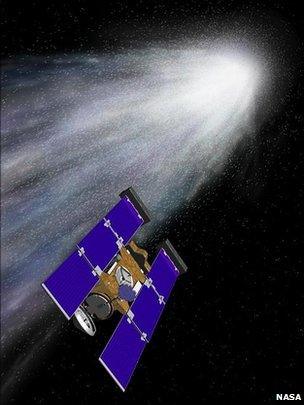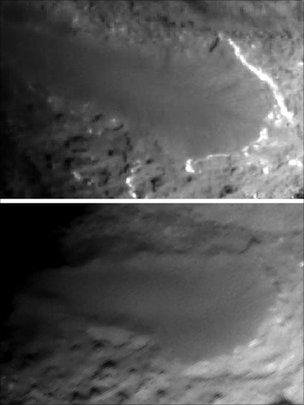Stardust probe finds 'subdued' comet crater
- Published

Four different views of the 7.5km-wide comet. The images progress in time from left to right
Nasa's Stardust spacecraft has swept past the comet Tempel 1.
Images from the encounter early on Tuesday (GMT) should give scientists unique information on how these great balls of ice and dust change over time.
Tempel 1 was visited by another probe back in 2005. It fired a projectile at the body to disturb the surface.
The crater left by that impact is visible in the new pictures, but its soft outline suggests some of the pit's features have undergone modification.
The 2005 spacecraft, which was called appropriately Deep Impact, never got to see the crater because its view was obscured by all the ice thrown up in the collision.
"We saw it; we saw the crater and it's subdued," said Pete Schultz, a co-investigator on the Stardust mission from Brown University.
"It's about 150m across and has a small central mound. It looks as if from the impact that the stuff went up and came back down. So we did get it; there's no doubt. And I think one of the bottom-line messages is that this surface of the comet where we hit is very weak. It's fragile; the crater partly healed itself."
Although often referred to as Comet Tempel 1, the object's official designation is actually 9P/Tempel.
The Stardust spacecraft went to within 180km of the 7.5km-wide object, passing by at some 10.9km/s.
All the systems onboard the probe, including the camera and dust analysis instruments, performed as expected.

Nasa called the Stardust extension mission a very cost effective bonus
The one glitch was a software issue that prevented the probe from prioritising its data return to concentrate on the pictures form the period of closest approach.
Instead, Stardust merely sent back the images in the order it took them - from far-out to close-in.
"This did not jeopardise any of the data that we had onboard; all the data was safely stored in memory and was ready to be sent down," explained the Stardust mission project manager, Tim Larson. "We just had to wait a little bit longer for those images that all of us were really ready to see at that time."
Stardust was commanded to take more than 70 high-resolution pictures, and the dust analysis instruments investigated the environment around the comet.
The data will be pored over by scientists for years, but it was immediately clear from the information at hand that the object had experienced significant change since the Deep Impact observations.
Areas that in 2005 had looked like flows of material on the surface appeared on this occasion to have undergone some erosion. There were new pits and wells to be seen, and new areas of layered terrain were also evident.
Principal investigator Joe Veverka from Cornell University said the alterations were driven by the process material loss as the comet orbited the Sun.
"When the comet comes close to the Sun, the temperature of the surface increases enough for the ices to start evaporating - that's why we see gases and dust coming from a comet. And so what you saw [in the new pictures] are places where during the last five years ice has evaporated and carried dust into space."

Evidence of the "subdued" crater: On the left is imagery acquired by Deep Impact in 2005 before the release of its projectile. Stardust's image on the right reveals the rim of a crater caused by the impactor
The Stardust spacecraft is on what Nasa calls a "bonus mission". The probe was launched back in 1999 with the primary goal then of visiting another comet altogether - Wild 2.
This it did in 2004, capturing dust particles from around the comet nucleus that it later returned to Earth in a capsule for study. But with sufficient fuel supplies still in its tanks, the probe was re-tasked by the US space agency to visit Tempel 1.
This extended mission has been dubbed Stardust-NExT, which is short for "New Exploration of Comet Tempel 1".

A smooth surface region seen by Deep Impact (top) has changed in the Stardust observation (bottom)
Nasa says the NExT phase of Stardust's life has cost just $29m. To have undertaken Tuesday's flyby with a brand new spacecraft would have cost $300-500m, it said.
This is the second comet rendezvous in just four months. In November, Deep Impact, itself also re-tasked by the agency, encountered Comet Hartley 2.
To date, spacecraft have flown close by seven comets - Tempel 1, Hartley 2, Borrelly, Wild 2, Halley, Giacobini-Zinner, and Grigg-Skjellerup (the missions to Giacobini-Zinner and Grigg-Skjellerup did not return pictures).
Comets are thought to contain materials that have remained largely unchanged since the formation of the Solar System. They incorporate compounds that are rich in carbon, hydrogen, oxygen and nitrogen.
Intriguingly these are the elements that make up nucleic and amino acids, the essential ingredients for life as we know it; and there are some who believe comet impacts in the early years of the Solar System could have seeded the Earth with the right chemical precursors for biology.
Tuesday's flyby event occurred at a huge distance from Earth - approximately 336 million km away. At that separation, radio messages take 18 minutes to travel to Earth.
- Published18 November 2010
- Published4 November 2010